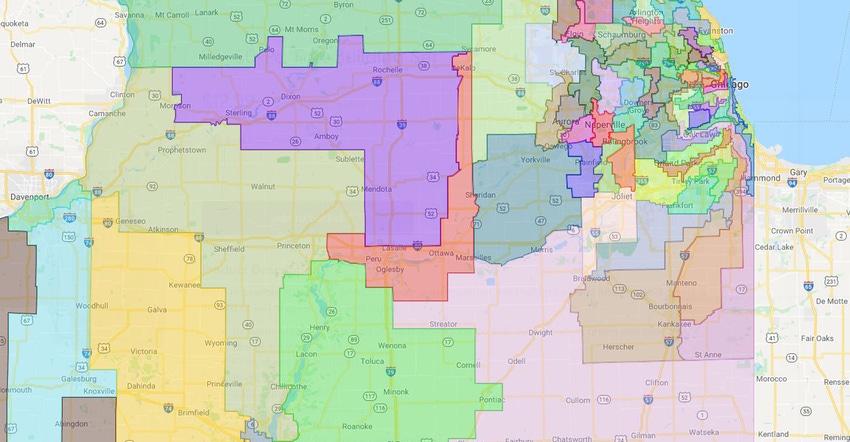October 14, 2021

Let’s acknowledge a couple of things.
Illinois is a blue state. The Democrats make the rules. They draw the maps that determine how you and I are represented in the General Assembly and in Congress.
Very few of us like these maps. Sure, they’re politically gerrymandered, but that’s not against the law. Minority groups say the General Assembly maps don’t accurately represent the Hispanic population in Illinois, which currently outpaces African Americans — and that may be against the law. Federal courts are deciding whether they are unconstitutional.
The Congressional map is equally gerrymandered, drawn to increase the Democratic majority in the U.S. House. Take a look at the new 17th District. It now catches Galena, Rockford, Moline, Macomb, Peoria, Bloomington and our farm, which is really something.
What’s it all mean for a bunch of farmers downstate?
I asked Patrick Pfingsten that question recently. Pfingsten is an Iroquois County native who’s spent time working conservative campaigns and last year started a subscription newsletter on Illinois politics called The Illinoize. All that to say, politics is his job, and he understands rural Illinois.
First, Pfingsten says, some perspective: Maps are drawn to protect the power of the incumbent party. In Illinois, that means Democrats have wielded the process to keep as many Democrats in office as possible, and to add more wherever possible. Republicans do the same thing in other states that aren’t Illinois.
And despite promises by Gov. J.B. Pritzker’s campaign to make it an independent, transparent process, it hasn’t been. Don’t let the facade of committees fool you; this mapping process has been a closed-door exercise between party leadership and staff.
Combo districts
But back to the General Assembly map. Pfingsten says Chicago has lost population to the suburbs since the last maps were drawn, so to keep the incumbent in power and draw a district with enough people, Democrats have drawn districts that snake out of Chicago, south and west into suburbs and, in some cases, into rural Illinois.
Take a look at the 17th Senate District. Current incumbent Elgie Sims Jr. lives near 88th Street and the Dan Ryan Expressway. His district has Chicago influence, but it runs in a narrow line along the Indiana border, picking up rural parts of Will and Kankakee counties, all the way to the farmland of the Ford-Iroquois county line. That means farmers in eastern Kankakee County have a senator from Chicago.
“There are numerous districts that will weave their way into the city and pick up a member’s house and then work west into the suburbs or south into very rural areas,” Pfingsten says, citing senate districts 15, 35, 36, 46, 48, 52 and 57. “They stuff enough rural voters in to protect the urban majority.”
Some folks call that collateral damage. Others call it an opportunity — like Kevin Semlow at Illinois Farm Bureau.
“Now those urban legislators have actual constituents who are farmers!” he says, with real enthusiasm. “I look at it as a blessing. Urban legislators are more invested in ag, and they have to pay attention.”
I admire his optimism. I really do.
But while those northern districts are combining rural and urban, downstate they’re being further separated. And that may be the bigger problem for ag.
As population moves out of the countryside and into cities, Champaign, Peoria, Bloomington-Normal and Decatur are all in districts that have had their surrounding countryside carved off. Cities stand alone. Semlow says that’s the bigger challenge coming for agriculture because it means more legislators won’t have strong personal ties to production ag.
Farm bureaus may have to start adopting downstate urban legislators, just like the Chicago legislators they’ve adopted for years.
Message for rural voters
Yet despite conscious efforts to reduce rural clout, our votes can still count. Pfingsten is emphatic about that. How?
“Get involved in your party primaries. Vote for the person that can win in November,” he says.
So, no matter your party, that means voting for the legislator who can go to Springfield, work across the aisle and get things done — not the candidate you agree with 100% of the time, but who won’t be able to accomplish anything because he or she leans so far right or so far left.
Governor, too. Farmers aren’t exclusively Republicans or Democrats, but let’s say you’re choosing a candidate for governor in the primary. Pfingsten says the smart vote is for the candidate who can appeal in the general election to moderates, independents and suburban people. Not the candidate who can go as far right or left as humanly possible.
Ask yourself: Can this person win in November? Then vote accordingly. That’s how you make a difference, no matter how the maps are drawn.
Editor’s note: Want to see where you land under the current maps? Check out the Illinois House and Senate and U.S. House maps here. Click on the magnifying glass to enter your address and see how the lines fall.
Comments? Email [email protected].
You May Also Like




